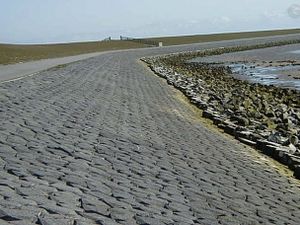Difference between revisions of "Revetment"
From Coastal Wiki
Dronkers J (talk | contribs) |
Dronkers J (talk | contribs) |
||
| Line 3: | Line 3: | ||
}} | }} | ||
| + | |||
| + | [[File:DikeRevetment.jpg|thumb|300px|left|Dike revetment.]] | ||
==See also== | ==See also== | ||
| Line 9: | Line 11: | ||
* [[Light revetments built-in into artificial dunes]]: Experiences from Polen with the application of light revetments built-in into artificial dunes to complement soft shoreline protection solutions. | * [[Light revetments built-in into artificial dunes]]: Experiences from Polen with the application of light revetments built-in into artificial dunes to complement soft shoreline protection solutions. | ||
* [[Stability of rubble mound breakwaters and shore revetments]] | * [[Stability of rubble mound breakwaters and shore revetments]] | ||
| + | |||
| + | <br clear=all> | ||
| + | |||
| + | |||
==Further reading== | ==Further reading== | ||
Mangor, K., Drønen, N. K., Kaergaard, K.H. and Kristensen, N.E. 2017. Shoreline management guidelines. DHI https://www.dhigroup.com/marine-water/ebook-shoreline-management-guidelines. | Mangor, K., Drønen, N. K., Kaergaard, K.H. and Kristensen, N.E. 2017. Shoreline management guidelines. DHI https://www.dhigroup.com/marine-water/ebook-shoreline-management-guidelines. | ||
Revision as of 10:55, 30 March 2021
Definition of Revetment:
A revetment is a facing of stone, concrete units or slabs, etc., built to protect a scarp, the foot of a cliff or a dune, a dike or a seawall against erosion by wave action, storm surge and currents. This definition is very similar to the definition of a seawall, however a revetment does not protect against flooding. Furthermore, a revetment is often a supplement to other types of protection such as seawalls and dikes.
This is the common definition for Revetment, other definitions can be discussed in the article
|
See also
- Revetments: article on different types of revetments, characteristics and application in practice.
- Seawalls and revetments: article on the effectiveness of seawalls and revetments to solve coastal engineering problems.
- Light revetments built-in into artificial dunes: Experiences from Polen with the application of light revetments built-in into artificial dunes to complement soft shoreline protection solutions.
- Stability of rubble mound breakwaters and shore revetments
Further reading
Mangor, K., Drønen, N. K., Kaergaard, K.H. and Kristensen, N.E. 2017. Shoreline management guidelines. DHI https://www.dhigroup.com/marine-water/ebook-shoreline-management-guidelines.
